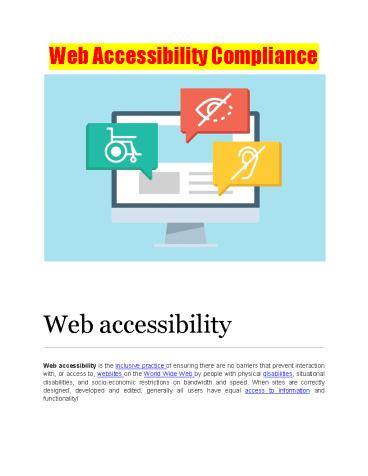Web Accessibility Compliance - PowerPoint PPT Presentation
Title:
Web Accessibility Compliance
Description:
Assisting you to ensure that your website is accessible to persons with disabilities required under the Americans with Disabilities Act (ADA) Section 508, Title II, and Title III in accordance with the Web Content Accessibility Guidelines (WCAG)! – PowerPoint PPT presentation
Number of Views:129
Title: Web Accessibility Compliance
1
Web Accessibility Compliance
Web accessibility
Web accessibility is the inclusive practice of
ensuring there are no barriers that prevent
interaction with, or access to, websites on the
World Wide Web by people with physical
disabilities, situational disabilities, and
socio-economic restrictions on bandwidth and
speed. When sites are correctly designed,
developed and edited, generally all users have
equal access to information and functionality!
2
- For example, when a site is coded with
semantically meaningful HTML, with textual
equivalents provided for images and with links
named meaningfully, this helps blind users using
text-to-speech software and/or text-to-Braille
hardware. When text and images are large and/or
enlargeable, it is easier for users with poor
sight to read and understand the content. When
links are underlined (or otherwise
differentiated) as well as colored, this ensures
that color blind users will be able to notice
them. When clickable links and areas are large,
this helps users who cannot control a mouse with
precision. When pages are not coded in a way that
hinders navigation by means of the keyboard
alone, or a single switch access device alone,
this helps users who cannot use a mouse or even a
standard keyboard. When videos are closed
captioned or a sign language version is
available, deaf and hard-of-hearing users can
understand the video. When flashing effects are
avoided or made optional, users prone to
seizures caused by these effects are not put at
risk. And when content is written in plain
language and illustrated with instructional
diagrams and animations, users with dyslexia and
learning difficulties are better able to
understand the content. When sites are correctly
built and maintained, all of these users can be
accommodated without decreasing the usability of
the site for non-disabled users. - The needs that web accessibility aims to address
include - Visual Visual impairments including blindness,
various common types of low vision and poor
eyesight, various types of color blindness - Motor/mobility e.g. difficulty or inability to
use the hands, including tremors, muscle
slowness, loss of fine muscle control, etc., due
to conditions such as Parkinson's disease,
muscular dystrophy, cerebral palsy, stroke - Auditory Deafness or hearing impairments,
including individuals who are hard of - hearing
- Seizures Photo epileptic seizures caused by
visual strobe or flashing effects. - Cognitive and intellectual Developmental
disabilities, learning difficulties (dyslexia,
dyscalculia, etc.), and cognitive disabilities
(PTSD, Alzheimer's) of various origins,
affecting memory, attention, developmental
"maturity", problem-solving and logic skills,
etc. - Accessibility is not confined to the list above,
rather it extends to anyone who is experiencing
any permanent, temporary or situational
disability. Situational disability refers to
someone who may be experiencing a boundary based
on the current experience. For example, a person
may be situationally one-handed if they are
carrying a baby. Web accessibility should be
mindful of users experiencing a wide variety of
barriers. - Source W ikipedia
- Assisting you to ensure that your website is
accessible to persons with disabilities required
under the Americans with Disabilities Act (ADA)
Section 508, Title II, and Title III in
accordance with the Web Content Accessibility - Guidelines (WCAG)!
3
ADA Site Compliance
https//adasitecompliance.com/
8401 Lake Worth Rd Lake Worth, FL 33467
info_at_adasitecompliance.com (561) 258-9300
https//www.facebook.com/ADAsitecompliance/
https//twitter.com/siteCompliance
https//www.instagram.com/adasitecompliance/
https//www.linkedin.com/company/adasitecompliance
/ https//www.youtube.com/channel/UCCf20J8_Uf2S4K
Gnq2uAo2A/featured































